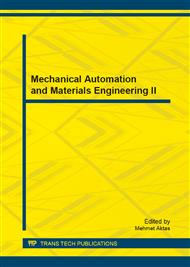p.135
p.139
p.144
p.148
p.153
p.159
p.164
p.169
p.173
Research of Modal Analysis Based on Different Modeling Methods and Different Element Types
Abstract:
The results of the same modal analysis exhibit obvious diversity due to the different options of the finite element types and the modeling methods. Modal analysis was carried out on EMU aluminum alloy welded profile using finite element analysis, then mode shape and natural frequency of each model was abstracted, and then the results of simulation and experimental were contrastively analyzed. Based on these, a fast and reliable modeling method and a reasonable element type were obtained, which would be able to eliminate the blindness of the choice of modeling methods and element type, thus achieving a more reasonable theoretical analysis results that provide the reference for structure design and verification and the basis for improving the efficiency and precision of simulation analysis.
Info:
Periodical:
Pages:
153-158
Citation:
Online since:
June 2014
Authors:
Keywords:
Price:
Сopyright:
© 2014 Trans Tech Publications Ltd. All Rights Reserved
Share:
Citation:


